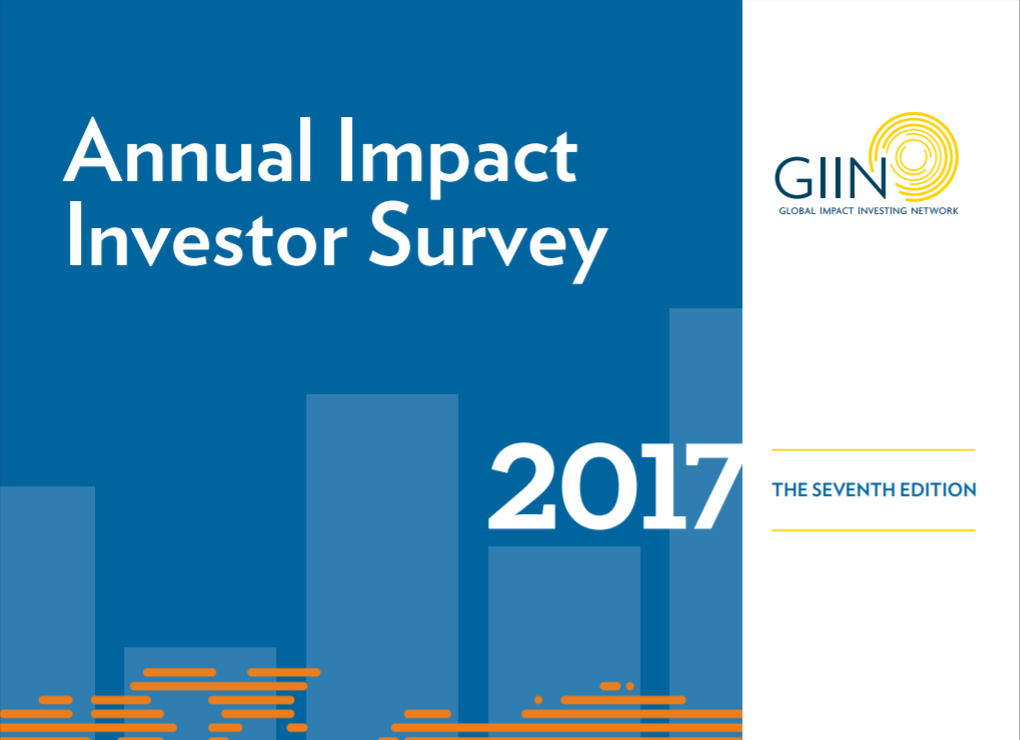
31 May 2017 Annual Impact Investor Survey
Each year the results of our Annual Impact Investor Survey are eagerly awaited as the data offer an increasingly descriptive view of a dynamic and evolving impact investment market. At the Global Impact Investing Network (GIIN), we are often encouraged by the survey findings, pleased to see indications that the market will realize the potential we envisioned for it years ago. This year, once again, the data attest to the industry’s momentum. We received responses from 209 impact investing organizations, the largest number ever, and captured evidence for a rising pool of impact investing assets—nearly USD 114 billion in AUM, a data point that is often used as a “floor” for the size of the impact investing market. And, perhaps most encouraging, investors continue to be overwhelmingly satisfied with the performance of their investments—both in terms of financial return and the impact they generate. Ten years into the creation of a formal impact investing industry, we are digging even deeper into the data and exploring the hard questions the survey surfaces about the market’s development. Where has impact investing fallen short of expectations? Which challenges still require innovation and solutions? This year’s Annual Impact Investor Survey, undoubtedly our most robust survey yet, surfaces insights into the topics that are at the forefront of industry conversations:
1. There isn’t one single way to be an impact investor. Many different types of impact investors pursue a variety of impact objectives and financial return targets. Although much attention is paid to impact investing’s ability to generate market-rate returns, about one-third of impact investors deliberately target below-market-rate returns. Nearly all survey respondents noted the valuable roles below-market investments can play in the market, including taking on more risk, investing in untested models or regions, and, in some cases, preparing businesses for scale investors. We will need to further explore how we can fully tap the collaborative potential of our diversity, such as by using blended capital structures to simultaneously bring in more capital and enhance impact.
2. The bar is high for large firms entering the industry. It is thrilling to see investors of all types enter the market, especially when their entry enhances the profile of the industry, but judgement should be withheld on any new entrant until the investor demonstrates a rigorous commitment to impact—the core ethos of the practice. While respondents feel that the entry of large-scale firms will help professionalize the market and bring credibility and much-needed capital, they also have concerns that this trend could lead to mission drift or “impact dilution.” We need to explore approaches to protect the integrity of the industry and keep impact at the forefront, while also welcoming new entrants. The GIIN’s vision of the market is not to integrate impact into traditional capital markets, but to integrate the capital markets into the global pursuit of social and environmental progress.
3. Multi-national initiatives have built demand for impact investments. Approximately 60% of investors reported that they actively track the financial performance of their investments with respect to the Sustainable Development Goals (SDGs) or plan to do so soon. The SDGs and the COP21 agreement have highlighted the scale and urgency of the issues the global community faces. The initiatives provide a cohesive framework for how to address these challenges, particularly the urgent need for private capital to step up and fill the funding gap. The world is looking to impact investing to fulfill this role, and clients and companies increasingly seek out impact strategies, inspired by the role their money can play in building a brighter future.
These topics present opportunities for collaboration and collective action for the GIIN and the impact investing community at large. At the current stage in the market’s development, we must reflect on market progress and refocus our attention on our final target. We have the tremendous opportunity to not just keep pace with the traditional capital markets, but to reinvent them entirely. The decisions we make today have the potential to shift attitudes, transform systems, and build the sustainable economy of the future. I look forward to reading our 2027 Impact Investor Survey and marveling at how far the next ten years have taken us.
To read the whole survey: https://thegiin.org/assets/GIIN_AnnualImpactInvestorSurvey_2017_Web_Final.pdf
— Amit Bouri Co-Founder and CEO, Global Impact Investing Network



